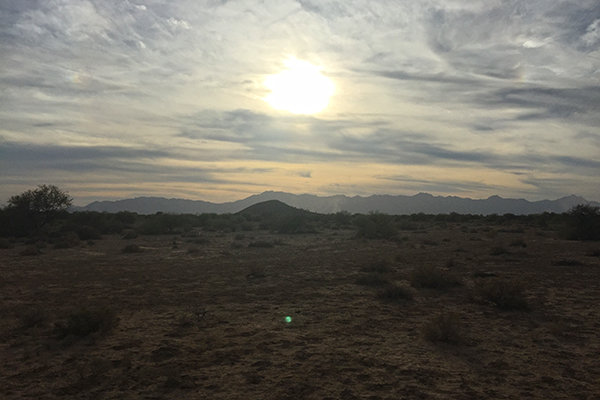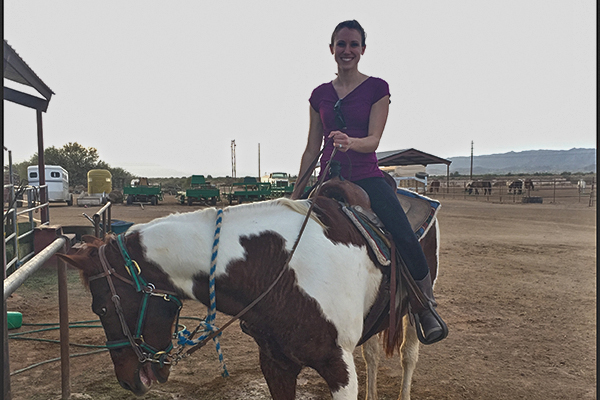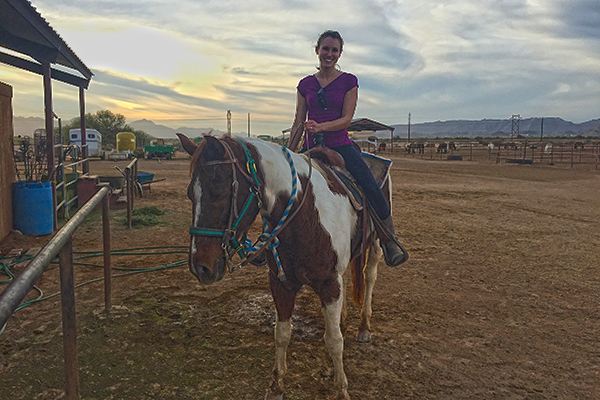(Editor’s note: This is Casey’s third segment in the “Hoof Beats” blog series, which describes her travels in Indian Country on horseback. Read her first blog here and her second here.)
For my next ride, I was back in Arizona touring a portion of the 600-square-mile Gila River Indian Reservation at the tribe’s Koli Equestrian Center just outside of Phoenix.
With my car’s thermometer hovering above a record-breaking 101 degrees for a winter’s day, I left the cool comfort of my rental car, saddled up, and followed my guide, Robert, across the desert landscape. Having parents of both Pima and Maricopa descent, Robert recounted for me in remarkable detail the history of these peoples and the region. (Watch some video to view the landscape below.)
The Pima are also known as the Akimel O’odham, or “people of the river,” because of their reliance on the nearby Gila River to irrigate their fields of corn, squash, beans and cotton.
As early as the 1600s, the Pima welcomed to their land the Maricopa, who were pressured out of the Colorado River region by other Yuman tribes, including the Quechan and Mohave Indians. The Pima and Maricopa tribes remain friendly today, and in fact, they’re governed by a single tribal council while still following their own separate traditions.

The Gila River is a lifeblood in a region where only 8 inches of rain fall each year. Unfortunately in the 1870s, white and other non-Native farmers diverted the river’s flow upstream, and the Akimel O’odham were left without water for their farms.
I later read more on the Gila River Indian Community website about the devastating effects: as crops dried up, famine and starvation abounded, followed by poverty and its crippling side effects like alcoholism and the loss of some cultural and artistic traditions.
The Akimel O’odham persevered through this physical and resulting emotional and cultural drought for over half a century when, in the 1930s, water from the Gila River began flowing back onto their land, piped from the Coolidge Dam’s San Carlos Reservoir more than 100 miles away.
As we leapt over one such irrigation ditch during our ride, Robert also described an encounter he had with a large owl one evening — an especially harrowing sight for him since Pimas believe owls take a soul to the other world at death.
We saw evidence of the hundreds of wild horses that roam the open land in packs of one to two dozen horses, including hoofprints of a mother and baby. Robert recalled how one of the wild stallions (male horse) even fathered a foal (baby horse) out of one of the equestrian center’s tame mares (female horse)!
Most intriguing was Robert’s account of the Pima’s use of calendar sticks, or Oos:hikbina, to record history in the absence of a formal written language. A notch was carved onto a cactus rib for each unit of time, with symbols etched and colored with dyes from native plants to represent important events that occurred during that time.
Because the symbols are essentially cues, the stick keeper was charged with remembering the events associated with each symbol and passing along the historical account to the next stick keeper. If a calendar stick was personal to an individual, it was usually burned when that person died.
The National Museum of the American Indian has a stunning Akimel O’odham calendar stick in its collections, which records events from 1833 to 1886, such as battles with rival tribes and the coming of the railroads.

Regrettably, my time at the Koli Equestrian Center passed all too quickly. I had a memorable time meandering through the scrub and cacti, taking in the stunning views of lone butte and the surrounding mountains and spotting the occasional desert critter, all while hearing first hand from Robert about the heritage of his people. Sadly, I didn’t see any of the wild horses, but this just means I’ll have to go back!
References:
Books:
“Tiller’s Guide to Indian Country,” by Veronica Tiller (pages 215-217)
“Desert Dwellers: Native People of the American Southwest” by Scott S. Warren (pages 22-27)
“Nations of the Southwest” by Amanda Bishop and Bobbie Kalman (pages 18-19)
Websites:
Gila River Indian Community’s history page
InMaricopa article: “Wild horses still run in desert in near Maricopa”
Accessed book “Yuman Tribes of the Gila River” by Leslie Spier
National Museum of the American Indian, Oos:hikbina (calendar stick)
Advertisement Disclaimer: The YouTube account for Travois, including this video, may contain advertisements for third parties. Travois does not endorse third parties in exchange for advertising and Travois is not responsible for the content of the advertisements.
Read more:


